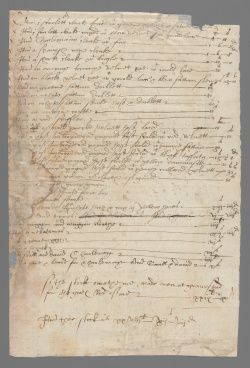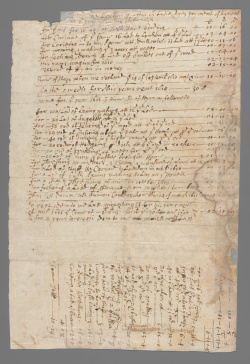Saul and David
Historical Records
Alleyn's list of theatrical costumes
A single folio leaf, undated but possibly c.1589-91, acquired by the Houghton Library in the early 1970s (as part of a larger MS collection) includes a costed inventory of theatrical costumes, apparently compiled by John Alleyn and at one time in the possession of Edward Alleyn. It was first found in a copy of John Payne Collier's The History of English Dramatic Poetry (1831), which Collier had presented to Joseph Hazlewood the year it was published. Hazlewood had it inserted between pp.88-89 of volume 3. It thereafter passed to Augustus, sixth Lord Vernon, and ultimately to Arthur Freeman before Harvard acquired it (see Evans 254-55).

|

|
| f MS Thr 276 recto | f MS Thr 276 verso |
f MS Thr 276, Houghton Library, Harvard University; reproduced by permission.
[fol. 1r] includes the following items pertaining explicitly to the lost "Saul and David" play (it is possible that other items on the list also belonged to "Saul and David" or were at least shared by that play and the "Charlemagne" play also listed):
- X Itm saull and dauid. Charlemayn __________________________iiijll
- X Itm a hare & beard for Charlemayn And Saull & dauid ___________xs
The £4 paid for "Saul and David" and "Charlemagne" is apparently for the playbooks.
Theatrical Provenance
Unknown; Wiggins (#815) suggests the play "may have entered the repertory of a touring company, perhaps one bound for the Continent" (presumably his conjecture rests on the concluding comment, "so the stock oweth me made euen at grauesend" in line 31 -- Gravesend being a possible port (see Evans 266). Evans suggests an association with the Worcester's or Admiral's companies, on the basis of the Alleyn connection (266).
Probable Genre(s)
Biblical.
Possible Narrative and Dramatic Sources or Analogues
Bible (1 Samuel 16-31).
Saul seeks out a talented harpist to relieve his melancholy; David is sent to him, and his playing has the desired effect. Saul leads the battle against the Philistines, but looks set to lose until David slays the giant Goliath by means of a slingshot and subsequently beheads the corpse. After earning Saul's respect, David becomes friends with Saul's son Jonathan. Saul, however, becomes displeased when the women of the cities of Israel celebrate David's valour in battle instead of Saul's. Saul attempts to use a javelin to kill David, who ultimately flees. Saul attempts to ensnare David, luring him back by the prospect of marriage to one of Saul's daughters. David declines the offer, citing his impoverished state and inability to provide any dowry in exchange for becoming son-in-law to a king. Saul seeks to have David killed by the Philistines by requesting a hundred foreskins of the Philistines in lieu of a dowry. David kills two hundred, and thus marries Saul's daughter Michal, but Jonathan reveals that Saul still wants David dead, and David flees. He seeks sanctuary with Achish the king of Gath but is recognised as Goliath's killer; he feigns madness for his own safety, and finds refuge in a cave. There, four hundred discontent men gather around David; they are pursued by Saul across Israel. David has a chance to kill Saul but instead merely cuts his clothes and spares his life. When Saul sees the offcuts from his own clothing and realises how close he came to death, he is remorseful for having pursued David. David subsequently has another opportunity to kill Saul, but declines to raise his hand against the Lord's anointed king; he merely confiscates Saul's spear and water. Nevertheless, David anticipates being killed by Saul if he were to remain nearby, so flees once again. Saul seeks God's advice but fails to receive an answer, so he disguises himself and seeks out the witch of Endor, who summons the spirit of Samuel the prophet. Saul learns that David will succeed him as king. In battle, the Philistines kill Saul's sons and the archers hit him; Saul asks his armourbearer to kill him, but the armourbearer refuses. Saul falls on his own sword; the armourbearer follows.
References to the Play
Information welcome.
Critical Commentary
Evans' suggestion (267) that "Saul and David" may be a prequel of sorts to Peele's David and Bathsheba has not gained scholarly acceptance; it rests on Peele's line about making "a third discourse of David's life" (the implication being that David and Bathsheba is the second discourse, and a first discourse -- "Saul and David" -- preceded it). Wiggins (815) calls the argument "flawed on several grounds", including the fact that an announcement of a sequel (the third discourse) would surely have been made in an epilogue not an interim chorus, and the fact that Peele's play has a tripartite structure (so the reference is an internal one).
For What It's Worth
Other items in Alleyn's list that may or may not be associated with the "Saul and David" play include various cloaks and doublets described only by their colour and material; white and yellow beards; periwigs; a "waggon and waggon cloathe", a "trunck"; and more specifically, "a hermyttes gray gown", a "pasytes [parasite's] sewte for a boy", and "a clownes sewte".
Works Cited
Site created and maintained by David McInnis, University of Melbourne; updated 18 May 2017.